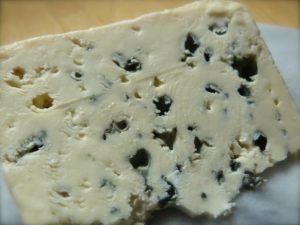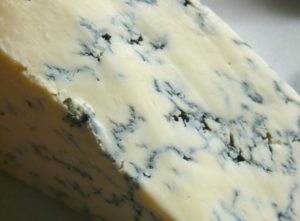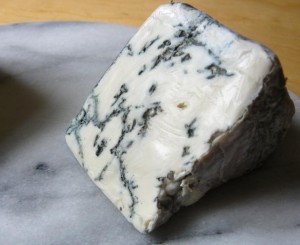
Editor’s Note: This sponsored column is written by Katie Carter, cheesemonger at Arrowine (4508 Lee Highway)
The story of blue cheese is the story of the balance between great milk and the blue penicillium mold, our attempts to control the two, and the pleasure we experience when it’s done right. A happy accident led to the discovery of this special category of cheeses.
 The tale goes that a young shepherd left his lunch of bread and cheese near the natural caves of Cambalou in the Roquefort-sur-Soulzon region of France. When he returned to fetch his food a few days later, he discovered his cheese had grown mold. Not wanting to waste his food, the shepherd ate the moldy cheese, which turned out to be delicious! By leaving his cheese to grow mold (penicillium roqueforti) native to that very particular cave, this shepherd inadvertently created the very first Roquefort cheese.
The tale goes that a young shepherd left his lunch of bread and cheese near the natural caves of Cambalou in the Roquefort-sur-Soulzon region of France. When he returned to fetch his food a few days later, he discovered his cheese had grown mold. Not wanting to waste his food, the shepherd ate the moldy cheese, which turned out to be delicious! By leaving his cheese to grow mold (penicillium roqueforti) native to that very particular cave, this shepherd inadvertently created the very first Roquefort cheese.
Today, almost all of the blue cheese produced around the world are made using the cultivated mold from these special caves. It is usually added to the milk in liquid form before coagulation but some cheesemakers still use a powdered version. The blue-green mold needs air to grow, so most blues are either pierced with needles or have a very open texture (air pockets) where the mold forms. Willi Schmid is the only producer I know of that creates an intentional pattern by splitting the cheese with a knife a few weeks after production.
The best blues are not overpowered by the flavor of the mold. The cheese and mold should harmonize and work together to create a unique, yet balanced, experience. Blues are naturally stronger in flavor than most other cheeses but not all blues are intense. They can range from very buttery with a slight spice to incredibly bold and acidic. Queso Cabrales is the strongest blue I have come across. Some people love it; I find it way too strong to eat on its own.
Stilton
 Dating back to the 18th century, Stilton is England’s most famous blue cheese. It was described in the early 1720’s by author Daniel Defoe as, “English Parmesan, and is brought to the table with the mites or maggots round it so thick that they bring a spoon with them for you to eat the mites with, as you do the cheese.” Fortunately, maggots are no longer present in the blue cheese and is enjoyed instead with a glass of port. Though it is a classic winter cheese, Stilton can be enjoyed throughout the year. Made today only with pasteurized cow’s milk, it is buttery and rich while the blue veining adds a pleasant acidity. Look for Stilton made by the Colston Bassett creamery, the best and oldest Stilton producer.
Dating back to the 18th century, Stilton is England’s most famous blue cheese. It was described in the early 1720’s by author Daniel Defoe as, “English Parmesan, and is brought to the table with the mites or maggots round it so thick that they bring a spoon with them for you to eat the mites with, as you do the cheese.” Fortunately, maggots are no longer present in the blue cheese and is enjoyed instead with a glass of port. Though it is a classic winter cheese, Stilton can be enjoyed throughout the year. Made today only with pasteurized cow’s milk, it is buttery and rich while the blue veining adds a pleasant acidity. Look for Stilton made by the Colston Bassett creamery, the best and oldest Stilton producer.
Roquefort
This very famous cheese was the first French cheese to gain AOC status and is only made by seven producers today. Made with raw sheep’s milk, this cheese can only be made in the region of Roquefort-sur-Soulzon in France and must be aged in the natural Cambalou caves. This semi soft cheese has a very white paste with an open texture that allows the greenish blue mold to grow within. The flavor is distinctly strong and powerful with a peppery bite and salty finish. This is the most elegant of all blue cheese and is best enjoyed with a sweet white wine, such as Sauternes.
The milk of only four water buffalo is used to create this amazing Swiss blue. Though these huge beasts look fierce and rugged, their milk is rich, sweet, and gentle. It makes the perfect backdrop to the sharp blue mold that marbles the interior and acts as a rind. This very rare cheese is quite special, give it a try if you ever come across it.
Monte Enebro
This unique Spanish blue, made with pasteurized goat’s milk, has a dense and thick paste. It is neither pierced nor does it have an open texture so the penicillium roqueforti grows only on the exterior of the cheese. The cheese has fun and bright flavors and can often taste tropical. Always taste before you buy this cheese, its window of perfection is small.
Katie Carter is Arlington’s first and only ACS Certified Cheese Professional. She has worked in the cheese industry for ten years as a cheesemaker, cheesemonger, and educator. She can be found on Twitter @AfinaCheese. The views and opinions expressed in the column are those of the author and do not necessarily reflect the views of ARLnow.com.


